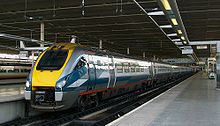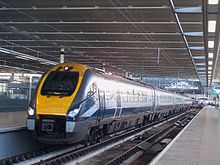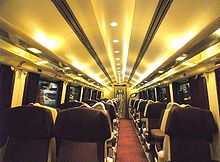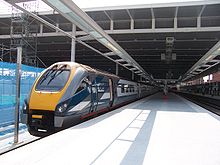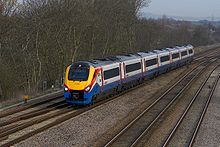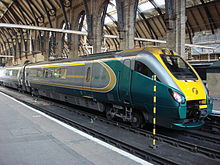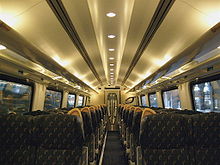- British Rail Class 222
-
British Rail Class 222 "Meridian" 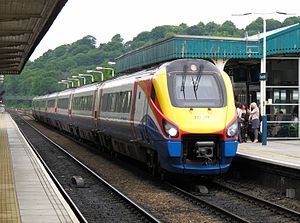
East Midlands Trains 222001 at Chesterfield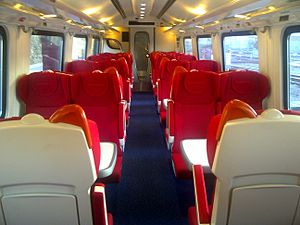
The new refurbished interior of Standard Class aboard a Class 222/0 Meridian No. 222008In service 2004– Manufacturer Bombardier Transportation Family name Voyager Constructed 2003–2005 Refurbishment 2011–2012 [1] Number built 27 trainsets Number in service 27 trainsets Formation 4, 5, or 7 cars per trainset Fleet numbers 222001–222023
222101–222104Operator East Midlands Trains Line(s) served Midland Main Line
Oakham to Kettering LineSpecifications Car body construction Steel Car length 23.85 m (78 ft 3 in) end cars
22.82 m (74 ft 10 in) otherWidth 2.73 m (8 ft 11 in) Maximum speed 125 mph (200 km/h) Engine(s) Cummins QSK19 Power output 750 hp (560 kW) per car UIC classification 1A'A1'+1A'A1'+...+1A'A1' Braking system(s) Rheostatic Safety system(s) AWS, TPWS Coupling system Dellner[2] The British Rail Class 222 is a diesel-electric multiple unit high-speed train capable of 125 mph (200 km/h). Twenty-seven units have been built by Bombardier Transportation.
The Class 222 is similar to the Class 220 Voyager and Class 221 SuperVoyager trains used by CrossCountry and Virgin Trains but units have a different interior, which is less cramped than the Voyagers. The Class 222 trains have more components fitted under the floors to free up space within the body.
Contents
Details
All coaches are equipped with a Cummins QSK19 diesel engine of 750 hp (560 kW) at 1800 rpm.[3] This powers a generator, which supplies current to motors driving two axles per coach. Approximately 1,350 miles (2,170 km) can be travelled between each refuelling.
Class 222 have rheostatic braking using the motors in reverse to generate electricity which is dissipated as heat through resistors situated on the roof of each coach, this saves on brake pad wear.
In common with the Class 220s, B5000 lightweight bogies are used - these are easily recognisable since the entire outer surface of the wheel is visible, with inboard axle bearings.
The Class 222 are fitted with Dellner couplers,[4] as on Class 220 Voyager and Class 221 SuperVoyager trains,[4] though these units cannot work together in service because the Class 222 electrical connections differ from that of the Class 220 and Class 221 trains.[4][clarification needed]
All Class 222 units are maintained at the dedicated Etches Park depot in Derby which is just south of Derby station.
Formation
Class 222 units are currently running in the following formations:
East Midlands Trains: seven cars with 236 standard seats and 106 first-class seats.- Coach A - Standard Class with driving cab and reservable space for four bikes
- Coach C - Standard Class
- Coach D - Standard Class
- Coach E - Standard Class with Shop/Buffet counter
- Coach F - First Class
- Coach G - First Class
- Coach J - First Class and driving cab
East Midlands Trains: four/five cars with 192 standard seats and 50 first-class seats (five cars).- Coach A - Standard Class with driving cab and reservable space for four bikes
- Coach B - Standard Class (not present in four-car train)
- Coach C - Standard Class with Shop/Buffet counter
- Coach D - Standard Class / First Class (four-car trains have a higher percentage of standard class seats)
- Coach G - First Class and driving cab
Initially, the 23 units ordered for Midland Mainline were 4-car and 9-car. Over time these have been gradually modified to the current formations. The 4-car units ordered by Hull Trains had an option when constructed to be extended to 5-cars if required.[5]
Operations
Midland region
Midland Mainline introduced the first of 23 Class 222 units on 31 May 2004, branding them Meridian. These replaced a fleet of Class 170 Turbostars having better acceleration and top speed.
Seven of the sets were nine car Class 222 Meridians which intended for an enhanced London St Pancras to Leeds service, but after the trains had been ordered, the Strategic Rail Authority decided not to allow them to run the service.[6] The nine-car Meridians were used on London-Nottingham and some London-Sheffield services.
When the trains were ordered, Midland Mainline overestimated the number of first class passengers and the four-car Meridians had less standard-class seating than the three-car Turbostars they replaced. Coach D subsequently had a section of first-class seating declassified for use by standard-class passengers.
At the end of 2006 Midland Mainline removed a carriage from the each of the nine-car sets and extended seven of the four-car sets.
Following the formation of the new East Midlands rail franchise on November 2007, the entire fleet of Class 222 Meridians was inherited by East Midlands Trains who operate the expanded East Midlands rail franchise including all those routes previously run by Midland Mainline.
East Midlands Trains has named the following Meridians:
Unit number Name Date named Named by Notes 222 003 Tornado 24 March 2009 Tim Shoveller, East Midlands Trains Managing Director Driving car 60163 named as it has the same number as Tornado 222 006 The Carbon Cutter 31 May 2011 Philip Hammond, Transport Secretary To mark the introduction of eco-mode to the fleet Midland Mainline had named some of the units as follows:
Unit number Name Date named Named by 222 004 City Of Sheffield 29 March 2007 Lord Mayor of Sheffield, Councillor Jackie Drayton 222 005 City Of Nottingham 30 January 2007 Lord Mayor of Nottingham, Councillor Des Wilson 222 006 City Of Leicester 7 March 2007 Lord Mayor of Leicester, Councillor Paul Westley 222 007 City Of Derby 17 May 2007 Mayor of Derby, Councillor John Ahern The names were removed when the franchise passed to East Midlands Trains.
In 2008 further rearrangements were made to the sets: another carriage was removed one coach from the eight-car Meridians, except for 222 007, which has been reduced to five-cars.[7] The surplus coaches were then added to the remaining four-car Meridians to make six seven-car sets (222 001-222 006) and 17 five-car sets (222 007-222 023). This process took place from March to October 2008; as part of the process two first class coaches removed from 222 007 were converted to standard class and part first class.
The seven-car trains are almost exclusively used on the fast services between London St Pancras and Sheffield. These do not operate the London St Pancras-Leeds, although the service is via Sheffield. The five-car trains are mainly used between London St Pancras and Sheffield, Nottingham or Corby on semi-fast services. The four-car trains supplement the five-car trains on these services.
In December 2008 the Class 222 Meridians started work on the hourly London St Pancras to Sheffield services, because they have faster acceleration than the High Speed Trains and so were able to reduce the Sheffield to London journey time by 12 minutes. The hourly Nottingham service was then transferred to High Speed Train running to cover for the Meridians now working the hourly Sheffield fast service.[8]
In February 2009, 222 101 and 222 102 transferred from Hull Trains to East Midlands Trains, they were quickly repainted in the East Midlands Trains white livery. 222 104 followed from First Hull Trains later in the year. 222 103 followed a few months after 222 104 after repairs had been completed (see below). None of them been refurbished internally. 222103 has now been reinstated for service after two years for repairs after the unit fell from jacks at Bombardier, Crofton in early 2007.
Hull services
First Hull Trains (formerly known as 'Hull Trains') introduced Class 222 Pioneer units, to replace its Class 170 Turbostars in May 2005. The units reduced journey times between Hull and King's Cross by up to 20 minutes. The Pioneers have a different interior colour scheme and less first-class seating than the Meridians.
First Hull Trains' fleet consisted of four four-car Pioneers, each named after a 'modern-day pioneer' related to Hull.
222 101 Professor George Gray 222 102 Professor Stuart Palmer 222 103 Dr John Godber 222 104 Sir Terry Farrell 222 103 was involved in an accident during maintenance work that severely damaged two of the unit's four cars.
First Hull Trains have decided to use only Class 180 units from 2009 onwards. The Class 222 Pioneers have now been transferred to East Midlands Trains[9] and are now known as Meridians.
Refurbishment
East Midlands Trains are currently undertaking a refurbishment of the entire Class 222 Meridian fleet. The refurbishment includes new seat covers and carpets in standard class. First class will receive new leather seat covers along with a new colour scheme and carpets. The refurbishment started in February 2011 and is set to be complete by Spring 2012.[10] A photo of the refurbishment in standard class can be seen at the top of this page.
Incidents
- On 10 June 2006 the 1030 1D17 Midland Mainline London-Sheffield service using Meridian 222 009 had to be taken out of service due to a door opening at Desborough, Northamptonshire whilst at speed.[11]
- In January 2007 eight jack supports failed, leading to unit 222 103 Dr John Godber of Hull Trains falling to the floor of Crofton Works. On inspection at Derby, two vehicles of the unit were written off, with replacements on order from Bombardier.[citation needed]
- First Hull Trains Pioneer 222 102 from Hull to London Kings Cross caught fire whilst travelling through Stevenage in Hertfordshire at approximately 19:20 on Friday 10 August 2007. The fire was reported to take 30 minutes to extinguish and no injuries were reported. Damage to the unit was not serious and it was back in service within two days.[citation needed]
- EMT 222104 had a fuel leak whilst in service on 24/06/2009. The unit has been fixed and is back in service.[citation needed]
- EMT 222016 was out of service after it was involved in a fatality incident near Elstree at the end of January 2010. 222016 has now recently re-entered service with a new cab, painted all-yellow making it look different to the other members of the fleet. It is identical to the rest now(excluding the numbers), because EMT repainted its cab to the standard livery. [12]
Derailment near Market Harborough
On 20 February 2010, 222005 working the 14:55 London St Pancras - Sheffield derailed near East Langton, Leicestershire. Two wheels on coach E in the middle of the train came off the track; on approaching the site of the derailment the train was travelling at close to 100 mph. No other wheels derailed and the train remained upright. There were also reports that one or more road vehicles on an adjacent highway were struck and damaged by debris as the derailed train passed.[citation needed] 222005 was moved from the site the next day after a replacement bogie was fitted and was for a few months formed of vehicles of 222101 and 222022 including a standard class cab end which was temporarily renumbered until the damaged vehicles were returned to the set in mid-June. The derailment caused damage to the Midland Main Line near Kibworth for a distance of two miles, the line underwent emergency repairs by Network Rail to get the stretch of line back open for start of service on 24 February 2010. The RAIB working with Bombardier and East Midlands Trains are currently investigating the incident. The RAIB’s preliminary examination has identified that the derailment is likely to have been the result of the failure of an axle in proximity to the final drive. Bombardier examined the rest of the 22X fleet within seven days of the incident and found no similar faults, however modifications have since been made to all the 22X fleet to monitor the gearbox oil levels more effectively.[13]
Other prospective operators
Enterprise
In 2005 HSBC Rail took delivery of the seven nine-car trains planned for use by Midland Mainline on their London-Leeds service, but the trains were left idle when the Strategic Rail Authority prevented Midland Mainline from operating this service. HSBC Rail made contact with Northern Ireland Railways and Iarnród Éireann, with a view to their leasing these units for use by Enterprise.[14] Using these trains on the Belfast-Dublin line was one of a number of options, which also included the purchase of additional 22000 Class railcars or cascaded coaching stock. In the event, the trains entered service with MML providing the fast services from London to Nottingham, thus releasing HSTs. The trains would have required significant modification to be used by Northern Ireland Railways, including reducing each train from nine to eight cars (the maximum length of stations on the Belfast-Dublin line), and converting them from standard gauge to Irish gauge (5 ft 3 inches).
Grand Central
Grand Central, on the announcement of its planned open-access operation to Sunderland in the summer of 2006, planned to run its services using five Class 222 units, with the intention of starting by the end of that year. However, this never happened, pushing back the planned start date while trying to source alternatives. Grand Central finally started operating in December 2007 using three High Speed Trains.[15]
Current fleet details
Class Operator No. in service Year Built[16] Cars per Set Unit numbers. Class 222/0 East Midlands Trains 6 2003 - 2005[17] 7 222001 - 222006 17 5 222007 - 222023 Class 222/1 4 4 222101 - 222104 References
- ^ "The News in Pictures". Railway Herald (257): p. 3. 2011-02-21. http://www.railwayherald.org/magazine/pdf/RHUK/Issue257HIGH.pdf. Retrieved 2011-02-21.
- ^ "Mechanical And Electrical Coupling Index". Rail Safety and Standards Board. http://www.rssb.co.uk/RGS/Pages/MECHANICALANDELECTRICALCOUPLINGINDEX.aspx. Retrieved 2010-12-20.
- ^ Class 222 data TheRailwayCentre.Com
- ^ a b c System Data for Mechanical and Electrical Coupling of Rail Vehicles - Rail Safety and Standards Board
- ^ Hull Trains launches Class 222 Meridian fleet - Railway Herald p2, Issue 4, 11/03/05
- ^ High Speed Hidden Asset - Railwatch, July 2005
- ^ "Changes to our trains". East Midlands Trains. 2008-06-06. Archived from the original on 2008-05-01. http://web.archive.org/web/20080501060427/http://www.eastmidlandstrains.co.uk/emtrains/aboutus/news/#{2243FFDD-C675-4207-9435-9D611E927AA3}. Retrieved 2008-06-21. "In preparation of our December 2008 timetable where we plan to run additional services we will be moving carriages between trains. Our smaller Meridian trains will get an extra carriage and some larger Meridian trains will lose one. By carrying out this work we will be improving our capacity on our smaller, busy trains in the peak hours where it is needed. Overall, we will reduce overcrowding at peak times."
- ^ East Midlands Trains FAQ Page
- ^ Modern Railways Issue 772 (November 2008)
- ^ East Midlands Train announce Meridian refurbishment
- ^ RAIB Report into incident
- ^ "Weekly Pictorial". Railway Herald (214): p. 18. 2010-03-08. http://www.railwayherald.org/magazine/pdf/RHUK/Issue214.pdf. Retrieved 2010-03-09.
- ^ Investigation into the derailment of a passenger train at East Langton, near Market Harborough, Leicestershire, on 20 February 2010 - RAIB, Feb 2010
- ^ IRRS Journal 157
- ^ The train now arriving from Sunderland is approximately… one year late - Rail Professional, Nov 2007
- ^ Marsden, Colin J (2010). Rail Guide 2010. Ian Allen. pp. 31–32. ISBN 978-0-7110-3457-0. */
- ^ Mark Herriott's Railway Photographs Midland Mainline Meridian Class 222 on Test In Belguim
External links
Diesel multiple units of the United Kingdom First generation units: First Generation
Original TOPS:First generation units
(pre-TOPS):British United Traction · Derby Lightweight · Metro-Cammell · Railbus · GWR Railcars · LMS Railcars
Second generation units: Diesel-electric units: Southern Railway designations: Families Categories:- British Rail diesel multiple units
- Bombardier multiple units
- British high-speed trains
Wikimedia Foundation. 2010.

